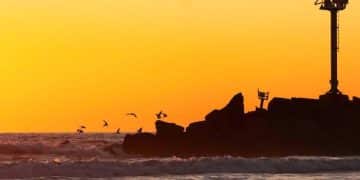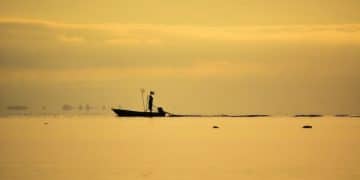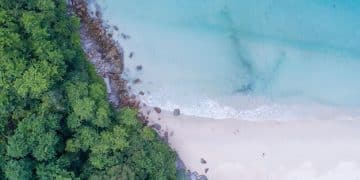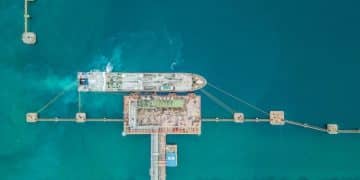Red Tide Alert: Impact on Coastal Tourism This Summer

A red tide alert signals the presence of harmful algal blooms (HABs) that can severely impact coastal ecosystems and significantly disrupt summer tourism, necessitating public awareness and proactive management strategies to mitigate economic and environmental consequences.
As summer approaches, a new concern looms over our beautiful coastlines: the re-emergence of red tide. Understanding the latest bloom and its impact on coastal tourism this summer is crucial for residents, visitors, and businesses alike.
Understanding Red Tide: The Science Behind the Bloom
Red tide, a term often used interchangeably with harmful algal bloom (HAB), refers to the discoloration of coastal waters caused by a dense accumulation of microscopic algae. While not all algal blooms are harmful, red tides specifically involve species that produce toxins, posing significant threats to marine life, human health, and, consequently, coastal economies. The current bloom under scrutiny presents a complex challenge, driven by a confluence of environmental factors.
These blooms typically occur when environmental conditions align perfectly for rapid algal growth. Factors such as nutrient-rich runoff from agricultural and urban areas, warmer ocean temperatures, and calm waters create an ideal breeding ground. The species primarily responsible for the present alert is Karenia brevis, known for producing neurotoxins that affect the central nervous systems of fish, marine mammals, and birds. These toxins can also become airborne, impacting human respiratory systems and posing risks to those recreating along affected shorelines.
The Biological Underpinnings of Harmful Algal Blooms
The life cycle of these microscopic organisms, while integral to marine food webs at low concentrations, can become problematic when their populations explode. This rapid proliferation, or bloom, depletes oxygen in the water as the algae decompose, leading to fish kills and creating dead zones. Furthermore, the toxins produced by certain species like Karenia brevis can bioaccumulate, moving up the food chain from shellfish to larger marine animals, ultimately affecting human consumers.
Ecological balance is severely disrupted during a significant red tide event. Beyond the immediate impact on marine life, the long-term effects on ecosystems can include:
- Disruption of benthic communities, impacting bottom-dwelling organisms.
- Altered food web dynamics, as toxin-laden organisms become consumed.
- Loss of critical marine habitats, such as seagrass beds and coral reefs, due to reduced light penetration and oxygen depletion.
The complex interplay between natural oceanographic processes and anthropogenically driven factors makes predicting the onset, duration, and severity of red tide alerts challenging. Scientists rely on a combination of satellite imagery, water sampling, and modeling to track and forecast these events, providing crucial data for public health and tourism advisories.
Environmental Triggers and Contributing Factors
Understanding the specific environmental conditions that trigger these blooms is key to mitigation efforts. Recent research points to several critical factors exacerbating the severity and frequency of red tides:
- Nutrient Pollution: Runoff from fertilizers and sewage introduces excess nitrogen and phosphorus into coastal waters, acting as primary nutrients for algal growth.
- Climate Change: Rising ocean temperatures and altered ocean currents may create more favorable conditions for HABs to thrive and expand their geographic range.
- Coastal Development: Changes in freshwater flow and habitat modification can disrupt natural water filtration systems, leading to increased nutrient loads in marine environments.
These factors often combine to create a perfect storm, allowing a small, localized bloom to escalate into a widespread red tide alert. The current alert is being closely monitored, with experts assessing how these environmental variables are contributing to its trajectory. Continuous monitoring and rapid dissemination of information are paramount to minimizing the impacts on affected communities and safeguarding both public health and economic interests.
In essence, red tide is more than just a discolored patch of water; it is a complex ecological phenomenon with deep scientific roots, driven by both natural cycles and human activity. Its presence necessitates a comprehensive understanding to effectively manage its impacts on our valuable coastal resources.
The Economic Fallout: How Red Tide Threatens Coastal Tourism
The economic ramifications of a red tide alert extend far beyond immediate losses in the tourism sector. Coastal communities, which often rely heavily on beach-goers, fishing charters, and waterfront commerce, face a multifaceted challenge as the bloom unfolds. The ripple effect can be felt throughout the local economy, from small businesses to large hospitality chains. This summer’s red tide alert serves as a stark reminder of the delicate balance between environmental health and economic prosperity.
When beaches are closed or deemed unsafe due to respiratory irritants and contaminated waters, the immediate impact on tourism is palpable. Hotels experience increased cancellations and reduced bookings, restaurants see fewer diners, and local shops lose out on tourist spending. The perception of an unsafe environment can linger long after a red tide dissipates, affecting future tourism seasons. This makes rapid communication and transparent information crucial for managing expectations and mitigating long-term damage.
Direct Impacts on Tourism and Hospitality
The core of coastal tourism revenue often comes from direct spending by visitors. This includes accommodation, dining, recreational activities like boating and fishing, and retail purchases. A red tide alert directly compromises all these income streams. For instance, fishing charters, a significant draw for many coastal areas, become unviable when fish populations are impacted and consumption of local seafood is advised against.
- Accommodation Cancellations: Hotels, Airbnb, and rental properties face significant booking reductions.
- Restaurant Downturn: Seafood restaurants are particularly hit, alongside general reduction in dining out.
- Activity Cease: Boating, fishing, swimming, and other water-based activities are halted or severely discouraged.
- Retail Sales Decline: Souvenir shops and other local businesses see fewer potential customers.
These direct impacts create a cascade effect, leading to reduced working hours for employees, potential layoffs, and a general decline in the local economic vitality. Understanding the magnitude of this direct hit is the first step in formulating effective recovery strategies.
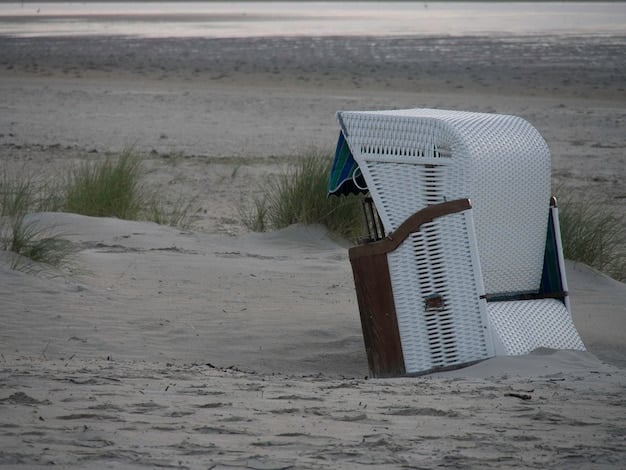
Indirect and Long-Term Economic Consequences
Beyond the immediate financial losses, a red tide alert can have insidious long-term effects. The damage to a region’s reputation as a pristine tourist destination can be substantial and difficult to reverse. Marketing efforts that emphasize clean beaches and healthy marine environments become less credible, and regaining consumer trust requires sustained campaigns and verifiable improvements in water quality.
Furthermore, the fishing industry, a vital component of many coastal economies, suffers significant losses. Fish kills deplete stocks, impacting commercial and recreational fishing for years. Shellfish harvesting often faces long-term closures due to accumulated toxins, affecting livelihoods and disrupting supply chains to markets beyond the immediate coastal zone.
- Reputational Damage: Long-term perception issues can deter future visitors, even when conditions improve.
- Fishing Industry Collapse: Depleted fish stocks and shellfish bed closures disrupt a major economic pillar.
- Reduced Property Values: Coastal properties might see a dip in value due to environmental concerns.
- Increased Healthcare Costs: Public health issues related to respiratory irritation can strain local healthcare systems.
These indirect consequences highlight the need for comprehensive approaches that not only address the immediate crisis but also invest in long-term environmental health and economic diversification. The economic impact underscores that red tide is not just an environmental issue but a critical fiscal challenge for affected coastal communities.
The current red tide alert presents a significant economic threat to coastal tourism this summer. Mitigating this impact requires concerted efforts from government agencies, local businesses, and residents to ensure transparent communication, support affected industries, and implement strategies for environmental recovery. The future of coastal economies hinges on our collective ability to respond effectively to these environmental challenges.
Public Health Concerns: Protecting Yourself and Your Family
When a red tide alert is issued, the primary concern, beyond economic impacts, is public health. The toxins produced by harmful algae can pose various health risks to humans and animals, ranging from mild respiratory irritation to severe neurological symptoms. Understanding these risks and knowing how to protect yourself and your family is paramount, especially for those planning to visit or reside along affected coastlines this summer.
The health effects depend on the specific type of toxin and the route of exposure. The most common exposure pathways during a red tide bloom include inhalation of airborne toxins, direct contact with contaminated water, and consumption of contaminated seafood. Authorities regularly monitor water quality and provide advisories to inform the public about the necessary precautions.
Inhalation and Respiratory Health Risks
One of the most widespread health complaints during a red tide is respiratory irritation. As toxins from the bloom become aerosolized through wave action, wind, or boat activity, they can be carried inland, affecting individuals with respiratory conditions such as asthma and emphysema more severely. Symptoms can include coughing, sneezing, watery eyes, and a scratchy throat.
For most healthy individuals, these symptoms are temporary and dissipate shortly after leaving the affected area. However, vulnerable populations, including young children, the elderly, and those with pre-existing respiratory issues, should exercise extreme caution. Medical guidance:
- Stay Indoors: Limit exposure to coastal areas, especially on windy days.
- Use Air Conditioning: Keep windows and doors closed at home and in vehicles.
- Consult a Doctor: If severe or persistent symptoms occur, seek medical attention.
Public health agencies often provide real-time updates on airborne toxin levels, allowing individuals to make informed decisions about outdoor activities. Adhering to these warnings is a simple yet effective way to protect respiratory health.
Contact, Ingestion, and Seafood Consumption Warnings
Direct contact with red tide water can lead to skin irritation, rashes, and burning eyes, especially for individuals with sensitive skin. It is advisable to rinse thoroughly with fresh water if contact occurs. More serious risks arise from intentional or accidental ingestion of contaminated water.
However, the most severe health risks are associated with the consumption of seafood contaminated with red tide toxins. Shellfish (clams, oysters, mussels, scallops) are particularly susceptible to accumulating these toxins without showing any signs of illness. Even cooking shellfish does not destroy the toxins. This can lead to various forms of shellfish poisoning:
- Neurotoxic Shellfish Poisoning (NSP): Caused by brevetoxins, leading to neurological and gastrointestinal symptoms.
- Paralytic Shellfish Poisoning (PSP): Caused by saxitoxins, potentially leading to paralysis and respiratory arrest.
- Amnesic Shellfish Poisoning (ASP): Caused by domoic acid, affecting the brain and causing memory loss.
Due to these risks, public health authorities issue strict warnings against consuming locally harvested shellfish during a red tide alert. While finfish are generally safe to eat if properly gutted and cleaned, as toxins tend to concentrate in their digestive organs, it is always best to check official advisories. Always purchase seafood from reputable sources and adhere to any local seafood consumption bans or recommendations.
Protecting yourself and your family during a red tide alert centers on awareness and adherence to public health advisories. By understanding the potential risks and taking appropriate precautions, individuals can minimize exposure and remain safe while coastal communities manage the broader impacts of the bloom.
Monitoring and Mitigation: How Scientists and Agencies Are Responding
In the face of an ongoing red tide alert, the coordinated efforts of scientists, government agencies, and local professionals are crucial for monitoring, predicting, and mitigating its impacts. Responding to harmful algal blooms is a complex task that requires cutting-edge technology, robust data collection, and swift communication strategies. The scientific community is tirelessly working to understand the current bloom’s dynamics, while agencies implement measures to protect public health and the environment.
Monitoring efforts often involve a multi-pronged approach, combining satellite imagery, aerial surveys, and extensive water sampling. This integrated strategy allows for a comprehensive understanding of the bloom’s extent, movement, and toxicity levels, enabling more accurate forecasts and timely advisories for the public and affected industries.
Advanced Monitoring Technologies and Data Collection
The ability to track red tide blooms in real-time has significantly improved thanks to advancements in monitoring technology. Satellites equipped with ocean color sensors can detect patches of algal blooms from space, providing a broad overview of their distribution. This macro-level data is then complemented by ground-level observations and detailed water quality analyses.
Scientists collect water samples from various coastal locations, analyzing them for the presence and concentration of red tide organisms and their toxins. This involves:
- Microscopic Analysis: Identifying and counting the specific algal cells responsible for the bloom.
- Toxin Assays: Measuring the concentration of harmful toxins present in water and shellfish samples.
- Environmental Sensors: Deploying autonomous sensors that continuously measure water parameters like temperature, salinity, and oxygen levels.
These data points are fed into sophisticated models that help predict the bloom’s trajectory and intensity. Such predictive capabilities are invaluable for issuing early warnings to coastal communities, allowing for proactive measures to be taken regarding beach closures, fishing restrictions, and public health advisories. The more precise the data, the more effective the response.
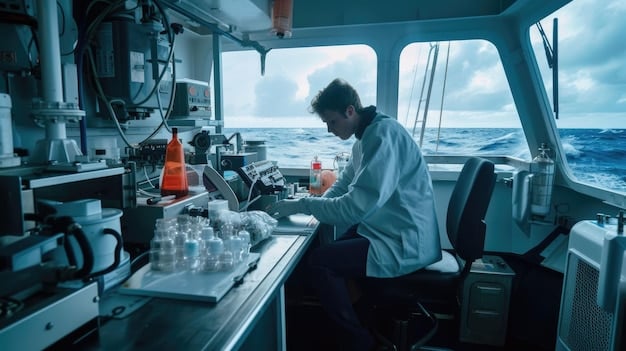
Mitigation Strategies and Emergency Response
While fully preventing red tide blooms remains a significant challenge, various mitigation strategies are employed to lessen their impact once they occur. These strategies range from short-term emergency responses to long-term efforts aimed at reducing the frequency and severity of future blooms. Emergency response typically involves a highly coordinated effort to minimize immediate harm.
Key mitigation and response actions include:
- Public Advisories: Rapid dissemination of information through traditional and social media channels about affected areas, health risks, and precautions.
- Beach Closures and Restricted Access: Implementing closures to protect public health and prevent exposure to airborne toxins.
- Fishery Closures: Banning shellfish harvesting and issuing advisories for finfish consumption to prevent human illness.
- Clean-up Operations: Removing dead fish and other marine life from beaches to maintain public hygiene and aesthetic value.
- Research and Development: Investing in scientific research to develop new technologies for bloom detection, forecasting, and potential control methods.
Longer-term mitigation efforts focus on addressing the root causes of red tides, particularly nutrient pollution. This involves working with agricultural industries to reduce fertilizer runoff, improving wastewater treatment infrastructure, and implementing regulations that protect coastal water quality. Collaborative efforts between state and federal agencies, along with local communities, are essential for designing and implementing effective strategies that balance environmental protection with economic realities.
The response to the current red tide alert highlights the critical role of scientific expertise and interagency cooperation. Through continuous monitoring and targeted mitigation efforts, scientists and agencies strive to protect natural resources, safeguard public health, and support the resilience of coastal communities against the challenges posed by harmful algal blooms.
Protecting Coastal Ecosystems: Environmental Impacts Beyond the Bloom
The immediate impacts of a red tide alert are often visibly dramatic: discolored waters, fish kills, and respiratory irritation. However, the true environmental devastation extends far beyond these obvious signs, permeating every level of the coastal ecosystem. A red tide bloom disrupts the delicate balance of marine life, impacting everything from microscopic organisms to apex predators. Understanding these broader ecological consequences is vital for assessing the full scope of a red tide event and for developing long-term conservation strategies.
When a red tide occurs, the primary ecological threat stems from the toxins produced by the algae and the subsequent hypoxia (low oxygen) or anoxia (no oxygen) conditions that develop as the bloom decomposes. These conditions can devastate marine habitats and alter fundamental food web dynamics, leading to cascading effects throughout the ecosystem.
Impact on Marine Life and Biodiversity
The toxins produced by red tide organisms, such as brevetoxins, are potent neurotoxins. When filter-feeding organisms like shellfish consume the toxic algae, these toxins accumulate in their tissues, making them dangerous for consumption by other marine life, including fish, marine mammals, and birds. This bioaccumulation and biomagnification up the food chain can lead to widespread animal deaths.
Critically, large-scale fish kills are a common and devastating consequence. Fish may die directly from exposure to high toxin concentrations in the water or from oxygen depletion as the massive algal bloom decomposes. The loss of vast numbers of fish not only impacts commercial and recreational fishing but also disrupts the food supply for countless other marine species, including:
- Marine Mammals: Dolphins, manatees, and whales can become ill or die from consuming contaminated fish or shellfish.
- Sea Birds: Birds that feed on fish or shellfish are also at high risk of toxin exposure.
- Bottom-Dwelling Organisms: Crabs, lobsters, and other invertebrates are affected by low oxygen levels and contaminated food sources.
The reduction in biodiversity can have long-lasting effects on ecosystem resilience, making it more vulnerable to future environmental disturbances. Protecting marine life during and after a red tide requires sustained efforts to monitor toxin levels and respond to wildlife emergencies.
Habitats and Ecosystem Functionality
Beyond direct toxicity, red tide blooms profoundly impact critical marine habitats. Dense algal blooms block sunlight from reaching the seafloor, inhibiting photosynthesis in seagrass beds and coral reefs. These habitats are vital nurseries and feeding grounds for numerous marine species, and their degradation can lead to a decline in fish populations and overall ecosystem health. The decomposition of large algal masses also consumes vast amounts of dissolved oxygen, creating dead zones where most marine life cannot survive.
The loss of these foundational habitats can:
- Reduce Fish Nurseries: Impairing the reproductive success and survival of many fish species.
- Erode Coastlines: As habitats like seagrass beds stabilize sediments, their loss can increase coastal erosion.
- Disrupt Nutrient Cycling: Altering the natural flow of nutrients through the ecosystem, potentially exacerbating future blooms.
Restoring these damaged habitats is a long and challenging process, underscoring the importance of preventative measures and long-term ecosystem management. The environmental impact of a red tide alert extends far beyond the duration of the bloom itself, leaving a lasting imprint on coastal ecosystems and requiring dedicated conservation efforts to promote recovery and resilience.
Ultimately, safeguarding coastal ecosystems from the profound effects of red tide requires a comprehensive approach that addresses immediate impacts, supports wildlife recovery, and implements long-term strategies for habitat restoration and pollution reduction. Our vigilance today shapes the health of our marine environments for generations to come.
Future Outlook and Long-Term Strategies for Coastal Resilience
The recurring nature of the red tide alert underscores the critical need for long-term strategies aimed at enhancing coastal resilience. As environmental conditions evolve and human pressures on coastal ecosystems intensify, understanding future outlooks and investing in sustainable solutions becomes paramount. The goal is not merely to react to individual blooms but to build robust coastal communities and ecosystems capable of withstanding these challenges with minimal long-term impact.
Developing coastal resilience involves a multifaceted approach, blending scientific research, policy implementation, community engagement, and economic diversification. This proactive stance contrasts with reactive measures, offering a more sustainable pathway for the future of our valuable coastal resources and the communities that depend on them.
Investing in Predictive Models and Research
A cornerstone of future resilience lies in improving our ability to predict and understand red tide dynamics. Continued investment in scientific research is essential to uncover the complex triggers and propagation mechanisms of harmful algal blooms. This includes:
- Advanced Modeling: Developing more sophisticated computer models that integrate oceanographic, meteorological, and ecological data to forecast bloom trajectories with greater accuracy.
- Genetic Research: Studying the genetic makeup of red tide organisms to understand their adaptability and potential vulnerabilities.
- Nutrient Source Tracking: Pinpointing the exact sources of nutrient pollution to target mitigation efforts more effectively.
These research efforts provide the foundational knowledge necessary for developing innovative solutions, from early warning systems to potential bloom control technologies. Collaborative research initiatives among universities, government agencies, and international partners are vital for accelerating progress in this field.
Policy, Infrastructure, and Community Engagement
Beyond scientific advancements, robust policy frameworks and infrastructure improvements are crucial for long-term coastal resilience. Policies aimed at reducing nutrient runoff from agricultural and urban areas, such as stricter regulations on fertilizer use and improved wastewater treatment, are fundamental to addressing a primary driver of red tide blooms. Investing in green infrastructure, like wetlands and riparian buffers, can also naturally filter pollutants before they reach coastal waters.
Furthermore, building community resilience involves educating the public and engaging local stakeholders in conservation efforts. This includes:
- Public Education Campaigns: Informing residents and tourists about the causes and impacts of red tide, and how they can contribute to prevention.
- Sustainable Practices Promotion: Encouraging local businesses and individuals to adopt practices that minimize environmental impact.
- Economic Diversification: Supporting local economies in diversifying beyond sole reliance on beach tourism to reduce vulnerability to environmental challenges.
Empowering local communities to participate in monitoring programs (e.g., citizen science initiatives) and decision-making processes fosters a sense of ownership and urgency. This collaborative approach ensures that strategies are not only scientifically sound but also socially and economically viable for those most affected by red tide events.
The future outlook for coastal regions facing recurrent red tide alerts hinges on a proactive and integrated strategy. By combining cutting-edge research with sound policy, infrastructure development, and active community engagement, we can build more resilient coastal ecosystems and economies capable of navigating the complexities of harmful algal blooms in the years to come.
Navigating the Summer: Advice for Residents and Tourists
As the red tide alert persists, residents and tourists alike face the challenge of navigating summer plans in affected coastal areas. While the allure of sun-kissed beaches remains strong, prioritizing health and safety is paramount. This section offers practical advice to help individuals make informed decisions, minimize exposure, and still enjoy aspects of coastal living, even during a bloom. Adaptation and awareness are key to making the most of your summer while staying safe.
It’s important to remember that conditions can change rapidly, with varying impacts even within short distances along the coastline. Therefore, staying updated with the latest information from official sources is the most crucial step. This proactive approach allows for flexibility in planning and ensures that activities align with current health advisories.
Staying Informed and Making Smart Choices
The first and most critical piece of advice is to constantly check official red tide status updates from reputable sources. These typically include state environmental agencies, local health departments, and tourism bureaus. Many provide online dashboards, hotlines, or social media updates with real-time information on beach conditions, respiratory forecasts, and shellfish harvesting advisories.
When reviewing these updates, pay attention to:
- Beach Status: Is the beach open or closed for swimming and recreation?
- Respiratory Forecasts: Are airborne toxins predicted to cause respiratory irritation? (Especially important for those with asthma or other respiratory conditions).
- Seafood Advisories: Are there any bans or warnings on consuming locally harvested fish or shellfish?
- Water Quality Readings: While often technical, these indicate toxin levels and bloom density.
Based on this information, make smart choices about your activities. If respiratory irritation is high, consider indoor activities or visiting parks away from the coast. If swimming advisories are in place, seek out pools or other non-coastal water activities. Being flexible and adaptable is essential to a safe and enjoyable summer.
Alternative Activities and Supporting Local Businesses
A red tide alert doesn’t mean your coastal summer plans are entirely ruined; it simply requires a shift in focus. Many coastal areas offer a wealth of activities that aren’t directly affected by water quality. Exploring these alternatives can provide a fulfilling experience while still supporting the local economy that is often hardest hit during a bloom.
Consider:
- Inland Attractions: Visit local museums, art galleries, historical sites, or nature preserves situated away from the immediate coastline.
- Dining and Shopping: Support local restaurants, particularly those that source seafood from unaffected regions or offer diverse menus. Explore boutique shops and local markets.
- Outdoor Activities (Away from Water): Enjoy hiking, biking trails, golf courses, or explore botanical gardens.
- Boating with Caution: If conditions permit and you have a boat, consider cruising in offshore waters where impacts might be less severe, but always check for advisories regarding water recreation.
- Spa and Wellness: Many resorts and towns offer excellent spa services, a perfect alternative for relaxation.
Engaging in these alternative activities not only diversifies your summer experience but also provides crucial support to local businesses struggling with reduced tourism. By demonstrating resilience and adapting plans, both residents and tourists can help coastal communities weather the financial storm of a red tide and look forward to clearer skies—and waters—ahead.
Navigating summer during a red tide alert requires a blend of vigilance, flexibility, and community support. By staying informed, protecting your health, and exploring alternative activities, you can still enjoy the summer while contributing to the resilience of our cherished coastal regions.
| Key Aspect | Brief Description |
|---|---|
| 🔬 Red Tide Basics | Harmful algal blooms (HABs) caused by toxin-producing algae, like Karenia brevis. |
| 💰 Economic Impact | Significant losses for coastal tourism, hospitality, and fishing industries due to closures and reputational damage. |
| 😷 Health Concerns | Risks include respiratory irritation from airborne toxins and severe illness from contaminated seafood consumption. |
| 🌱 Ecosystem Threat | Devastates marine life, damages habitats (seagrass, coral), and creates oxygen-depleted dead zones. |
Frequently Asked Questions About Red Tide
▼
Red tides are typically caused by dense concentrations of microscopic algae, often triggered by a combination of natural ocean conditions, such as warm water and calm seas, and human-induced factors like nutrient runoff from land. The timing often correlates with seasonal changes and increased nutrient loads from rainfall or other phenomena, creating ideal bloom conditions.
▼
It is generally not safe to swim during a red tide alert. Direct contact with affected water can cause skin irritation, rashes, and eye discomfort. More importantly, inhaling airborne toxins generated by wave action can lead to respiratory problems, especially for those with asthma or other breathing conditions. Always check local advisories before entering the water.
▼
Consuming shellfish (like oysters, clams, mussels) harvested from red tide affected areas is highly dangerous and can cause severe illness, including Neurotoxic Shellfish Poisoning. Toxins accumulate in their tissues and are not destroyed by cooking. Finfish are generally safer if properly gutted, but it’s crucial to consult local public health seafood advisories and bans before consuming any locally caught seafood.
▼
Red tide significantly impacts coastal tourism by causing beach closures, respiratory irritations, and concerns about seafood safety. This leads to a decrease in hotel bookings, restaurant patrons, and activity rentals, resulting in substantial economic losses for local businesses and communities. Reputational damage can also deter future visitors, affecting long-term tourism prospects.
▼
Authorities employ various strategies, including extensive monitoring via satellite and water sampling, issuing public health advisories, and implementing emergency beach and fishery closures. Long-term efforts focus on scientific research to understand bloom dynamics and developing mitigation strategies, such as reducing nutrient pollution into coastal waters to lessen the frequency and severity of future events.
Conclusion
The current red tide alert presents a complex environmental and economic challenge for coastal communities this summer. From devastating marine ecosystems to significantly impacting tourism and posing public health risks, the ripple effects are profound. While scientists and agencies are diligently monitoring and working towards mitigation, the sustained health of our coastlines hinges on our collective understanding, adaptability, and commitment to long-term environmental stewardship. By staying informed, supporting sustainable practices, and engaging in proactive measures, we can better navigate these challenging times and foster greater resilience for our invaluable coastal resources.
